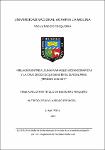Mostrar el registro sencillo del ítem
Relación entre algunas variables oceanográficas y la CPUE de Dosidicus gigas en el sur del Perú (periodo 2015-2017)
| dc.contributor.advisor | Icochea Salas, Luis Alfredo | |
| dc.contributor.author | Alvarado Espinoza, Alfredo Jesus | |
| dc.date.accessioned | 2023-10-23T14:33:18Z | |
| dc.date.available | 2023-10-23T14:33:18Z | |
| dc.date.issued | 2023 | |
| dc.identifier.uri | https://hdl.handle.net/20.500.12996/6016 | |
| dc.description | Universidad Nacional Agraria La Molina. Facultad de Pesquería. Departamento Académico de Manejo Pesquero y Medio Ambiente | es_PE |
| dc.description.abstract | En la presente investigación se estudió la relación entre algunas variables oceanográficas ylas CPUE(t/viaje) de Dosidicus gigas en el área sur del Perú, es decir, el área marítima peruana comprendida entre los 14°S hasta la frontera con Chile. Se utilizó datos pesqueros de pota durante el periodo 2015-2017 y datos oceanográficos provenientes del reanalysis oceánico GLORYS12V1 y de AQUA MODIS. El análisis de las CPUE mostró diferencias significativas entre E/P con capacidad de bodega menor a 10t (𝐶��𝑃��𝑈��𝐸��𝑝��𝑟��𝑜��𝑚��𝑒��𝑑��𝑖��𝑜��= 5.04 t/viaje) de las E/P con capacidad de bodega mayor a 10t (𝐶��𝑃��𝑈��𝐸��𝑝��𝑟��𝑜��𝑚��𝑒��𝑑��𝑖��𝑜��= 8.54 t/viaje). Siendo las primeras las que conforman mayoritariamente la flota potera en el sur del Perú. El Análisis espacio-temporal muestra que las zonas de pesca tienden a ser más oceánicas (con respecto a la distancia a la costa) durante invierno y primavera, siendo mayor las CPUE en primavera. La matriz de correlación y los Modelos Aditivos Generalizados (GAM) entre las variables oceanográficas y las CPUE de pota, mostraron que la salinidad a 55m es la variable que mejor explica las variaciones de la CPUE de pota. El Análisis de Componentes Principales (PCA) revelo la existencia de los siguientes patrones o modos oceanográficos y su relación con las CPUE. En verano: mezcla de Aguas Costeras Frías (ACF) y Aguas Subtropicales Superficiales (ASS) con mayor influencia de ASS a nivel subsuperficial produce en promedio mayores CPUE. En Otoño: no se encontró un patrón oceanográfico que muestre relación significativa con las CPUE. En Invierno: zonas de pesca con predominancia de ACF mostraron menores CPUE en promedio, mientras que altos valores de velocidad de corriente superficial y a 55m presentan en promedio mayores CPUE. En primavera: Las zonas de pesca con bajos valores de altura del nivel del mar y velocidad de corriente superficial y 55m, presentan en promedio bajas CPUE. | es_PE |
| dc.description.abstract | This study analyzes the relationship between some oceanographic variables and the CPUE (t/fishing trip) of Dosidicus gigas in the southern Peru, i.e, the Peruvian maritime area from 14°S to the border with Chile, using Dosidicus gigas data during the period 2015-2017 and oceanographic data from global ocean physics reanalysis GLORYS12V1 and NASA database AQUA MODIS. The CPUE analysis showed significant differences between fishing vessel (E/P) with fishing capacity of less than 10t (𝐶�𝑃�𝑈�𝐸�𝑚�𝑒�𝑎�𝑛�= 5.04 t/fishing trip) and E/P with fishing capacity greater than 10t (𝐶�𝑃�𝑈�𝐸�𝑚�𝑒�𝑎�𝑛�= 8.54 t/fishing trip). Being the first ones that make up the majority of the giant squid fleet in southern Peru. Spatiotemporal Analysis of CPUE showed that the fishing grounds tend to be more oceanic (with respect to the distance to the coast) in winter and spring, being CPUEs higher in spring. The correlation matrix and the Generalized Additive Models (GAM) between the oceanographic variables and CPUE, showed that salinity at 55m is the variable that best explains the CPUE’s variations of giant squid. The Principal Component Analysis (PCA) revealed the existence of the following patterns or oceanographic modes and its relationship with CPUE of giant squid. In summer: mixing of Cold Coastal Water (CCW) and Subtropical Surface Waters (SSW) with greater influence of SSW at the subsurface level produces higher CPUE on average. In autumn: it was not found a significant relationship between oceanographic patterns and CPUE. In winter: fishing grounds with a predominance of CCW show lower CPUE on average, while high values of surface current velocity and at 55m present higher CPUE on average. In spring: fishing grounds with low values of sea level height and surface current speed and at 55m, have low CPUE on average. | es_PE |
| dc.language.iso | spa | es_PE |
| dc.publisher | Universidad Nacional Agraria La Molina | es_PE |
| dc.rights | info:eu-repo/semantics/openAccess | es_PE |
| dc.rights.uri | https://creativecommons.org/licenses/by-nc-nd/4.0/ | es_PE |
| dc.subject | Dosidicus gigas | es_PE |
| dc.subject | Ballenas jorobadas | |
| dc.subject | Variables oceanográficas | |
| dc.subject | Comportamiento animal | |
| dc.subject | Sur del Perú | |
| dc.subject | Costa | |
| dc.subject | Costo energético del animal | |
| dc.subject | Efectos dañinos del ambiente | |
| dc.subject | Frecuencia respiratoria | |
| dc.subject | Observación | |
| dc.subject | Perturbación al animal | |
| dc.subject | Perú | |
| dc.subject | Seguimiento y evaluación | |
| dc.subject | Velocidad de nado | |
| dc.title | Relación entre algunas variables oceanográficas y la CPUE de Dosidicus gigas en el sur del Perú (periodo 2015-2017) | es_PE |
| dc.type | info:eu-repo/semantics/bachelorThesis | es_PE |
| dc.coverage | Lima. Perú | es_PE |
| thesis.degree.discipline | Pesquería | es_PE |
| thesis.degree.grantor | Universidad Nacional Agraria La Molina. Facultad de Pesquería | es_PE |
| thesis.degree.name | Ingeniero Pesquero | es_PE |
| dc.subject.ocde | https://purl.org/pe-repo/ocde/ford#1.05.11 | es_PE |
| renati.author.dni | 75344704 | es_PE |
| dc.publisher.country | PE | es_PE |
| dc.type.version | info:eu-repo/semantics/publishedVersion | es_PE |
| renati.advisor.orcid | https://orcid.org/0000-0003-1631-447X | es_PE |
| renati.advisor.dni | 09271954 | es_PE |
| renati.type | https://purl.org/pe-repo/renati/type#tesis | es_PE |
| renati.level | https://purl.org/pe-repo/renati/level#tituloProfesional | es_PE |
| renati.discipline | 831086 | es_PE |
| renati.juror | Mendo Aguilar, Jaime Humberto | |
| renati.juror | Carrillo La Rosa, Luis Lorenzo | |
| renati.juror | Cueto Vega, Rosa |
Ficheros en el ítem
Este ítem aparece en la(s) siguiente(s) colección(ones)
-
PES-MP Tesis [65]





